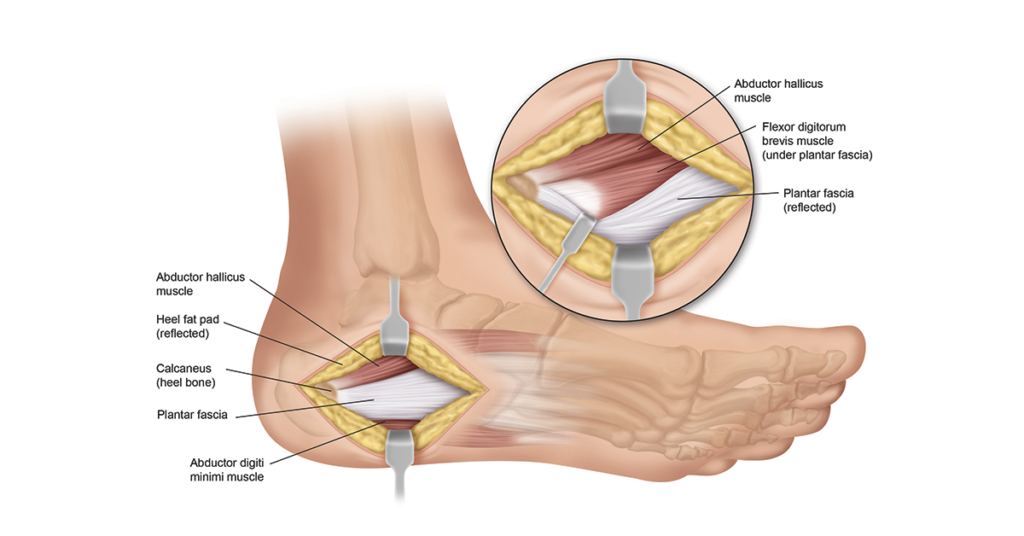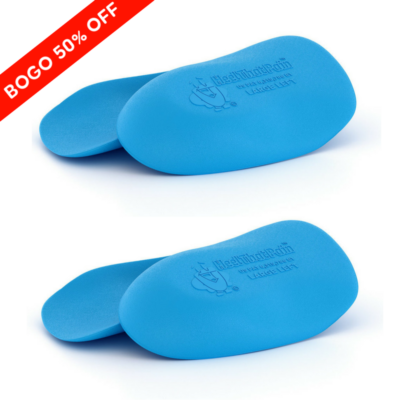Plantar Fasciitis Surgery
Surgery to correct plantar fasciitis is seen as a last-resort option when all more conservative treatment modalities have failed and is generally warranted in only about 5-10% of cases.
Also known as “plantar fascia release surgery,” the procedure involves making incisions in the plantar fascia ligament or detaching the ligament from the heel bone to relieve tension, either via open or endoscopic surgery.
Success Rates of Plantar Fascia Release Surgery
While most podiatrists hesitate to recommend surgery as a first-line treatment for plantar fasciitis (because of the expense, recovery time, and the fact that conservative treatments are typically so successful), those who need surgery can take comfort in the data that shows high rates of success for surgery.
Some studies point to very high success rates: one study from 2000 found a 93.6% success rate. However, a review of the studies in American Family Physician shows a more varied (but still encouraging) success rate in improving chronic plantar pain between 75% and 95%.
Types of Plantar Fasciitis Heel Surgeries
Depending on the severity of your plantar fasciitis, your unique needs, and your doctor’s recommendations you may undergo open surgery or endoscopic surgery for your plantar fasciitis:
Endoscopic Surgery
Endoscopic procedures (also called an endoscopic plantar fasciotomy or EPF) are the most common type of plantar fasciitis surgery. In an EPF, the surgeon will be inserting his instruments through tiny incisions on either side of the heel.
Endoscopic surgery is usually an outpatient procedure that’s done with sedation using twilight medication, or general anesthesia. The incision will be made on the side of your heel, after which a tiny camera will be inserted to allow your doctor to see inside your foot and cut out the damaged part of the fascia with a small hook. The whole process only takes about 15-20 minutes total, and the incision will be closed up with stitches.
With endoscopic surgery, you can wear shoes again as soon as you feel comfortable doing so, but you shouldn’t put weight on the foot for the first two weeks of recovery.
Open Surgery
If your orthopedic surgeon has recommended open surgery, they will be cutting a small area of the bottom of the foot open in order to operate with the plantar fascia ligament exposed.
In open surgery, your doctor will make an incision above your heel pad at the back of the heel. Your surgeon may help relieve tension to your plantar fascia by detaching it from the heel bone, removing heel spurs, freeing trapped nerves, or removing portions of scar tissue and adhesions. Recovery from this method will involve wearing a cast, walking boot, or brace for two to three weeks.

What Is the Recovery Time for Plantar Fasciitis Surgery?
Total recovery time for endoscopic plantar fasciitis operations tends to be three to six weeks, while open surgery takes a bit longer, at 6-10 weeks. Depending on your recovery, patients will usually need to wait as long as three months before participating in high-impact activities such as jogging. No matter what type of surgery you choose for your plantar fasciitis, you will be engaging in foot strengthening stretches to promote healing.
Because Plantar Fascia Surgery is an invasive procedure and requires a considerable recovery period, it should always be viewed as appropriate only in extreme cases which haven’t been resolved via non-invasive methods.
Other Plantar Fasciitis Remedies to Try Before Heel Surgery
No one wants to undergo an operation, and podiatrists state that 90% percent of Plantar Fasciitis cases can be resolved with a very simple, non-invasive strategy. Before you consider plantar fascia release surgery, be sure you have first made every effort to utilize other options, including the following:
- Commit to resting your feet twice a day for twenty minutes. Because of today’s busy schedules, many people find this a challenge, but if avoiding surgery is your goal, make a plan for giving your feet total rest two times a day. You might schedule this during your lunch break and during your free time after dinner. While resting your feet, apply an ice pack to reduce inflammation.
- Commit to performing daily plantar fascia and heel stretching exercises. Some people enjoy exercises and others don’t, but nearly everyone wants to be free of pain without having to resort to surgery. Make use of Heel That Pain’s excellent collection of free plantar fasciitis exercise videos. These simple stretches are designed to reduce morning heel pain and daily heel pain and to promote eventual recovery.
- Commit to wearing a specialized orthotic shoe insert, in all of your shoes, every day. Clinically-tested Heel Seats are proven to resolve the heel pain caused by Plantar Fasciitis in more than 9 out of 10 cases. Featuring patented Fascia-Bar technology not found in any other product on the market, Heel Seats gently re-align the compromised plantar fascia ligament, cushion the heel and deliver therapeutic acupressure to the heel bone, stimulating your body’s natural ability to heal itself.
- The above three techniques, implemented faithfully, resolve Plantar Fasciitis in the majority of cases, but if your case requires additional treatment, ask your physician about the risks and benefits of pain medications and cortisone injections as short-term aides.
While most Heel That Pain customers report significant heel pain relief in a week or less after using our orthotics, be prepared to commit to the above non-invasive treatment options for up to one year to achieve complete resolution of your condition. Plantar Fasciitis commonly develops over time as a result of a combination of stresses to the body and it takes time to heal. By making a serious commitment to do all you can to help your body heal naturally, you will be taking the best possible actions to regain your health without having to undergo surgery.
More Resources for Surgery
| Pros & Cons of Surgery | Topaz Surgery | Sarah’s Surgery Story |






